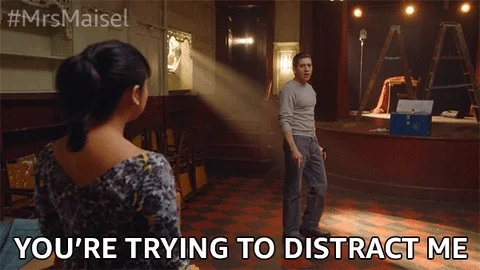You're in the middle of a debate arguing that your school should change the fast food menu in the cafeteria to include more fresh and healthy meals. You've finished presenting your argument, and it's now your opponent's turn to speak. They look at you, smile, and say: "No one's gonna listen to you because you're a nerd!"

What kind of response was that? Can they do that?
As confident as your opponent may be, you recognize this as a logical fallacy! Use this to your advantage — understand what logical fallacies are so that you can effectively respond to them.
What Is a Logical Fallacy?
A logical fallacy is a logical flaw in an argument. These flaws range from invalid points and deception to irrelevant or lacking evidence.
Whether used intentionally or by accident, logical fallacies are found in everyday life, especially when the goal of the argument is to persuade you. You can find logical fallacies in advertisements, social media posts, and political conversations, to name a few.

Logical Fallacy #1: Ad Hominem
Your opponent saying "No one's gonna listen to you because you're a nerd!" is an ad hominem.

An ad hominem is an attack not on the argument but on the speaker. This is often done as a distraction because the attention is on a person's character or trait and no longer on the topic.
 What are some signs of an ad hominem fallacy?
What are some signs of an ad hominem fallacy?
The argument is no longer about the topic. The majority of the debate is on the opponent.
The argument focuses on personal characteristics. This includes making fun of someone's looks or lifestyle. (Ex. "You can't be trusted; you're not wearing glasses!")
Personal attacks are thrown. The argument involves name-calling or insults toward the other speaker.
 How can you respond to this logical fallacy?
How can you respond to this logical fallacy?
Identify the fallacy. State that the argument is on the topic at hand — not on you.
Point out the irrelevance. Explain that attacking your character has nothing to do with the topic.
Redirect the topic back to the main point.
You tell your opponent that it doesn't matter whether or not you're a nerd because the debate isn't about your character but what school served for lunch. You successfully avoided a fight to focus on the argument rather than the person.
Logical Fallacy #2: Straw Man
Your opponent reads their notes and says, "People like you just don't like fast food and want everyone to eat salads every day!" Your argument is about introducing healthy meals onto the menu — not changing the menu to have only salads!

This is a straw man fallacy, which oversimplifies an argument to make it easier to attack or make it sound less convincing to the audience.
 What are some signs of a straw man fallacy?
What are some signs of a straw man fallacy?
Oversimplification/vague language. Overgeneralizing removes key details of the argument, making it easier to attack. (Ex. "Doctors should have at least four years of practice." --> "Doctors can't be trusted.")
Exaggeration. Making an argument sound more extreme than it actually is. (Ex. Person A wants all dogs to be on leashes at the park, and Person B misrepresents the argument as "So you want all dogs to be banned from public spaces?")
Putting the argument out of context. The argument is selective and removes key details that are needed to understand the situation.
 How can you respond to this fallacy?
How can you respond to this fallacy?
Identify the misinterpretation. Acknowledge that the argument is being oversimplified, exaggerated, or put out of context.
Explain the original argument in context.
Redirect the topic back to the main point.
Explain to the audience that your opponent is misrepresenting your argument by overexaggerating.
Restate your position, which helps your audience understand your argument without distractions.
Logical Fallacy #3: Red Herring
You ask your opponent why the school should serve pizza three days a week, and your opponent responds with: "The cafeteria ladies always give extra food to the kids who say hi to them. That's not fair!"

That's a red herring fallacy, which avoids the argument by introducing a new topic as a distraction. What does the lunch portion have to do with why the school has pizza for lunch Monday through Wednesday?
 What are some signs of a red herring fallacy?
What are some signs of a red herring fallacy?
Sudden change of topic and irrelevant details. The information is unrelated to your argument is introduced.
Logical inconsistencies. The details are disconnected from the topic, leading to contradictions or forced relationships where none exist.
 How can you respond to this logical fallacy?
How can you respond to this logical fallacy?
Point out the irrelevance. State that the topic is not relevant to the original argument and explain why. (Ex. "That has nothing to do with the original point because...")
Redirect the topic back to the main point.
You confidently state that portion sizes have nothing to do with what your school serves for lunch and encourage your opponent to address why pizza is served so often. The audience silently nods in agreement!
Identifying the red herring and redirecting the conversation helped prevent the audience from being misled and ensured that the key question was being addressed.
Why Do Logical Fallacies Weaken an Argument?

According to Purdue OWL, logical fallacies weaken an argument through distraction, misrepresentation, missing evidence, failure to address the main issue, or by providing false or irrelevant information. There are many examples of how this works:
They affect critical thinking and logic. Missing or false information affects how an argument is understood, which leads to false conclusions.
They can disrupt communication. For example, an ad hominem doesn't discuss the main argument but instead distracts the speakers and audience from the debate's purpose.
They make an argument/speaker less credible. Logical fallacies like the straw man or red herrings can mislead the audience, destroying trust and persuasiveness through misrepresentation.
Quiz
Your opponent makes a final argument: "With a menu change, we'll never have pizza again! Do you really want to ban pizza?" You know this is a fallacy! What kind is it?
Take Action
The audience is shocked by the logical fallacies presented by your opponent, but you know that these fallacies are common and can be done accidentally.
By calling out the flaws, you proved that these argument gaps weaken the opposition by attacking their logic and credibility. You made sure the discussion was productive by avoiding distractions and focusing on the main topic.
After hearing your clear arguments and recognizing the flawed logic behind the opposition, your classmates are ready to vote on whether they want to change the cafeteria menu to include healthier options!

Your feedback matters to us.
This Byte helped me better understand the topic.
